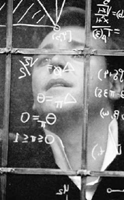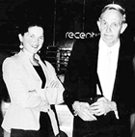The Ultimate Backstage Pass
December 13, 2001

Russell Crowe as John Nash in A Beautiful Mind. "I would spend six hours writing mathematics," says Dave Bayer, the film's mathematical consultant, "and Russell would demolish it in three seconds of frantic erasing." (Photograph by Eli Reed.)
The film, like Nasar's biography, is titled A Beautiful Mind; it is scheduled to open on December 21, with national release in early January. Based loosely on the book, the film can be described as "fictionalized biography."
For Dave Bayer---the Proof reviewer---the film was an invaluable opportunity to get outside the world of mathematics for five months and to work closely with people he clearly respects: Howard (who maintains "incredible clarity of thought" throughout the "daunting process of making a major film"), screenwriter Akiva Goldsman ("who has a high comfort level with technical content"), and Russell Crowe, the actor who plays John Nash ("who can read his surroundings quicker than anyone I've met").
What exactly does "mathematical help" with a film entail? SIAM News asks Bayer, who is a professor of mathematics at Barnard College. Given that his involvement in the project ran to hundreds of hours, the answer turns out to take a little time.
One of Bayer's contributions was the result of the serendipitous discovery---as Bayer was suggesting a hard problem for Crowe to give his calculus class---that Bayer and Crowe have very similar handwriting and also that their hands themselves look very much alike. From that day on, Bayer was Crowe's hand double. In the film, both Bayer and Crowe can be seen writing mathematics---on windows, on blackboards, and on paper; in some sequences, Bayer says, his hands and Crowe's alternate, from second to second, usually---but not always---writing math.
Bayer's five-month departure from the world of mathematics was anything but complete. To begin with, he had to familiarize himself with the mathematics Nash worked on (which readers of Nasar's biography will remember as quite diverse).
Most visibly, Bayer was responsible for the mathematical notation itself---not only writing out but imagining difficult mathematics that Nash might have worked on after he became insane. For one classroom scene late in the film, Bayer realized that the required blackboards of mathematics couldn't be achieved by copying material from paper. Rather, he thought of a hard problem---related to the Riemann hypothesis, on which Nash worked in real life---and then spent hours in the room writing the mathematics on a blackboard, overlapping and squeezing things in, striving for a realistic, suitably layered texture.
He also worked with the writers on mathematical dialogue; here he describes his role as offering the choice of a dozen or so lines that would ring true mathematically. Another interesting project: Working with the art department, Bayer wrote a program to produce randomized output, with some structure, for a room at the Pentagon filled with displayed code. What sort of mathematician would happily immerse himself in the world of film, even for a film driven by mathematics? Bayer, who works in algebraic geometry, recalls that from his undergraduate days, his reaction was to want to computerize the subject. Even in algebra, he says, his tendency has been to draw lots of pictures. In college and again recently, he found himself pulled toward topology, "because it's so visual." So when a film director was looking for someone to make mathematical content visual. . . .

John Nash with his biographer, Sylvia Nasar. The forthcoming film A Beautiful Mind is loosely based on Nasar's book; a new edition of the book, with an update bringing Nash's story up to the present day, will be released to coincide with the opening of the film. Princeton University Press will publish another related book at about the same time: The Essential John Nash, edited by Nasar and Harold Kuhn. Kuhn, a long-time friend and colleague of Nash, wrote the preface to the book, along with introductions to several of the included papers. (Photograph by Michael Intriligator.)

